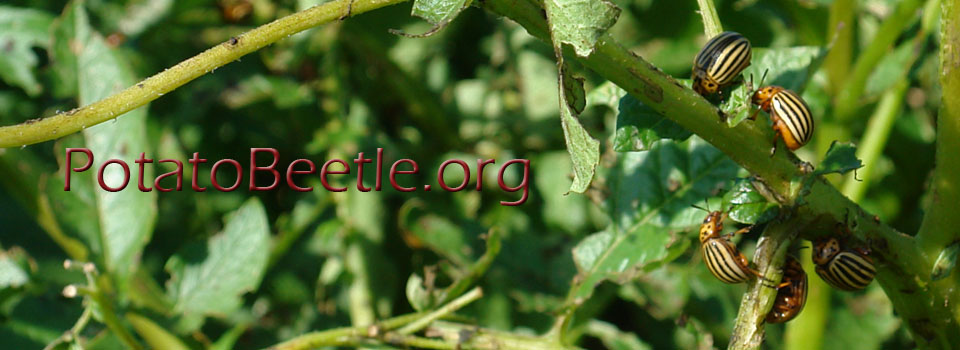Basic Principles
Ensuring long-term success in chemical pest control (which is another way of saying “preventing resistance development”) rests on the same three basic principles as ensuring long-term success in any other hostile encounter. First, you need to know your enemy. Secondly, you need to use a multiple attack strategy. Relying on a single tactic is usually doomed to failure, even if this tactic is sound in general (just think of an army that consists exclusively of tank brigades, without infantry, aviation, or engineering corps). Third, you need to strike hard, but stop once the adversary seizes hostilities and is ready to surrender. Remember that even a morning dove may become ferocious when cornered.
Knowledge Foundation
Although many details still need to be figured out, a significant amount of information on imidacloprid resistance in the Colorado potato beetle is already available. First, we know that resistance is a matter of frequency of resistant individuals in the population. Simple presence of resistant genes does not mean that a particular insecticide is doomed. As long as resistant individuals are few and far between, effective control may still be achieved. Secondly, in the absence of insecticides, fitness of resistant individuals is usually low compared to susceptible individuals. They have lower reproductive success, higher mortality, and are incapable of successful competition with their susceptible brethren. Third, resistant alleles are usually incompletely dominant, meaning that the level of resistance in hybrid crosses between resistant and susceptible beetles are somewhere in between that of their parents. Finally, when such hybrids mate with each other, some of their offspring will be highly resistant.
Plan of Action
1. Do not rely on insecticides alone. Every grower should practice crop rotation, which has been repeatedly shown to suppress Colorado potato beetle populations. Rotated fields should be located as far from the previous year’s crop as possible, so that the beetles have difficulty finding them. This would allow reducing the number of insecticide applications necessary to control the beetles (Fig. 1), thus reducing selection pressure towards resistance development.
Fig. 1. Mean number of insecticide applications required to control Colorado potato beetles on non-rotated and rotated commercial potato fields during the 2005 growing season in Southern Maine (A. Alyokhin, unpublished data).
2. Do not follow an insecticide with ANY other insecticides that have similar chemistry within the same season. Similar chemicals are likely to poison their target insects in a similar way. Therefore, if an insect becomes capable of overcoming one of them, it is fairly likely that it will also overcome another one that has a similar chemical structure and mode of action (Fig. 2). This phenomenon is known as cross-resistance.


Fig. 2. Damage done by imidacloprid-resistant Colorado potato beetles to experimental plots treated at planting with in-furrow formulations of two different neonicotinoid insecticides. A-plots treated with imidacloprid (Admire); B-plots treated with thiamethoxam (Platinum). Pictures are taken on August 4, 2005.
Insecticide Resistance Action Committee arranged all insecticides in groups based on the similarities in their chemical structures and modes of action (ways how they kill their target pests). Insecticides belonging to different mode of action groups (see Table 4.1 below) should be rotated throughout the growing season.
|
Group |
Subgroup |
Mode of Action |
Chemical group |
Product names |
|
1 |
A |
Acetylcholine esterase inhibitors |
Carbamates |
Furadan, Lannate, Sevin, Temik1, Vydate |
|
|
B |
|
Organophosphates |
Dimethoate, Di-Syston, , Guthion, Imidan, Malathion, Methyl Parathion, Mocap, Monitor, Penncap-M, Thimet/Phorate |
|
|
|
|
|
|
|
2 |
A |
GABA-gated chloride channel antagonists |
Cyclodiene organochlorines |
Phaser/Endosulfan |
|
|
|
|
|
|
|
3 |
|
Sodium channel modulators |
Pyrethroids, Pyrethrins |
Ambush, Asana, Baythroid, Decis, Leverage1, Pounce |
|
|
|
|
|
|
|
4 |
A |
Nicotinic acetylcholine receptor agonists / antagonists |
Neonicotinoids |
Actara, Admire, Alias, Assail, Belay, Cruiser, Gaucho, Genesis, Leverage2, Pasada, Platinum, Provado, Voliam Flexi3 |
|
|
|
|
|
|
|
5 |
|
Nicotinic acetylcholine receptor agonists (other than group 4) |
Spinosyns |
Success/SpinTor |
|
|
|
|
|
|
|
6 |
|
Chloride channel activators |
Avermectins |
ABBA, Agri-Mek |
|
|
|
|
|
|
|
11 |
|
Microbial disruptors of insect midgut membranes |
Bacillus thuringiensis subsp. tenebrionis |
Javelin, Dipel, Novodor, etc. |
|
|
|
|
|
|
|
15 |
|
Inhibitors of chitin biosynthesis, type 0, Lepidopteran |
Benzoylurea |
Rimon |
|
|
|
|
|
|
|
18 |
B |
Ecdysone agonists / moulting disruptors |
Azadirachtin |
Azadirect, Ecozin |
|
|
|
|
|
|
|
22 |
|
Voltage-dependent sodium channel blocker |
Indoxacarb |
Avaunt |
|
|
|
|
|
|
|
25 |
|
Neuronal inhibitors |
Bifenazate |
Acramite |
|
|
|
|
|
|
|
28 |
|
Ryanodine receptor modulators |
Diamides |
Altacor, Coragen, Voliam Flexi2 |
|
|
|
|
|
|
|
un |
|
Compounds of unknown or nonspecific mode of action (selective feeding blockers) |
Cryolite |
Kryocide |
|
1Temik is not registered for use in the State of Maine. Check with the local regulatory authorities on its availability in other areas. 2Leverage is a mixture of Baythroid (a pyrethroid) and Provado (a neonicotinoid). As such, it should follow neither pyrethroids nor neonicotinoids in a rotation sequence. 3Voliam Flexi is a mixture of rynaxypyr (a diamide) and thiamethoxam (a neonicotinoid). As such, it should follow neither diamides nor neonicotinoids in a rotation sequence. |
||||
3. Use economic thresholds when making decisions about spraying. Not only does chasing every single beetle with a sprayer result in a waste of time and money, but also it contributes to rapid resistance development. Trying to kill all the beetles with insecticides usually results in killing all susceptible beetles. Only resistant beetles survive (that’s why they are called resistant in the first place). When resistant beetles mate with each other, all their progeny are resistant. When resistant beetles mate with susceptible beetles, their progeny are less resistant, and usually can be killed by the full label rate of insecticide.
4. Leave refuges for susceptible beetles. If you apply insecticide in furrow or as a seed treatment to the whole field, you cannot use economic thresholds. However, you still need to supply susceptible mates for resistant beetles. Unless you intend to run a dating service for lonely beetles, leaving a few untreated rows at planting is your best solution. If needed, those can be treated later with foliar sprays.
5. Use full label rate of insecticides. Otherwise, you might not kill the hybrids between resistant and susceptible beetles (see above).
Preventing resistance is as essential a part of good insecticide stewardship as minimizing drift or wearing personal protective equipment. Similar to most other problems, it is easier avoided than mitigated. Therefore, necessary steps should be taken before insecticide failure becomes noticeable in the field.

